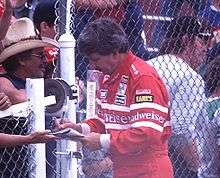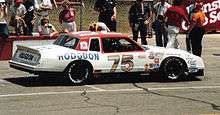Neil Bonnett
| Neil Bonnett | |||||||
|---|---|---|---|---|---|---|---|
 Bonnett in 1985 | |||||||
| Born |
July 30, 1946 Hueytown, Alabama | ||||||
| Died |
February 11, 1994 (aged 47) Daytona Beach, Florida | ||||||
| Cause of death | Autoracing accident during practice for the 1994 Daytona 500 | ||||||
| Achievements |
1982, 1983 World 600 Winner 1979 Firecracker 400 Winner | ||||||
| Awards |
Named one of NASCAR's 50 Greatest Drivers (1998) National Motorsports Press Association Hall of Fame inductee (1997) International Motorsports Hall of Fame inductee (2001) Winner of the first ever NASCAR race run outside of North America, the Goodyear NASCAR 500 held in Australia (1988) | ||||||
| NASCAR Sprint Cup Series career | |||||||
| 362 races run over 18 years | |||||||
| Best finish | 4th (1985) | ||||||
| First race | 1974 Nashville 420 (Nashville) | ||||||
| Last race | 1993 Hooters 500 (Atlanta) | ||||||
| First win | 1977 Capital City 400 (Richmond) | ||||||
| Last win | 1988 Goodwrench 500 (Rockingham) | ||||||
| |||||||
| Statistics current as of June 14, 2015. | |||||||

Lawrence Neil Bonnett (July 30, 1946 – February 11, 1994), known professionally as Neil Bonnett, was a NASCAR driver who compiled 18 victories and 20 poles over his 18-year career. The Alabama native currently ranks 45th in all-time NASCAR Cup victories.[1] He appeared in the 1983 film Stroker Ace and the 1990 film Days of Thunder. Bonnett hosted the TV show Winners for TNN from 1991 to 1994. He was a color commentator for CBS, TBS, and TNN in the years until his death.
NASCAR career
Bonnett began his NASCAR career as a protégé of 1983 Winston Cup champion Bobby Allison, working on the team's cars. He later became part of the famous "Alabama Gang" that included himself, Red Farmer and the Allison family: father Bobby, brother Donnie and, later, son Davey. He began driving in NASCAR in 1974 and earned his first victory in 1977 at the Capital City 400 in Richmond, Virginia driving for Harry Hyde-Jim Stacy Racing. He had another victory in 1977 at the Los Angeles Times 500, which would be the last Dodge win in NASCAR until 2001. Many in racing circles thought 1978 would be his year to dominate, but troubles with his cars (the new for '78 Dodge Magnum) and financial problems between Hyde and Stacy caused his cars to fail and to drop out of many races. In 1979 he hooked up with the Wood Brothers Racing Team and got his career back on track with three victories. He later won back-to-back World 600s (NASCAR's longest race, now the Coca-Cola 600 in 1982 and 1983) and back-to-back Busch Clash (now Bud Shootout) victories in 1983 and '84, including his first in which he did not win a single pole from the previous season, but was selected as a wild card entry.[2]
In 1984, Bonnett joined Junior Johnson's team, becoming a teammate to Darrell Waltrip. In 1985, he had one of his best seasons, finishing fourth in the points standings while Waltrip went on to win his third championship.
Bonnett participated in International Race of Champions (IROC) during three seasons (1979, 1980, and 1984), and finished second twice.
Bonnett holds the distinction of being the winner of the first ever NASCAR race held outside of North America when he won the 1988 Goodyear NASCAR 500 at the A$54 million Calder Park Thunderdome in Melbourne, Australia (at the time the newly opened Thunderdome was also the first NASCAR style speedway to be built outside of North America). The race, run two weeks after the Daytona 500, was not a Winston Cup race but featured some drivers from the series including fellow Alabama Gang member Bobby Allison, Michael Waltrip, Dave Marcis and Kyle Petty who were up against Australian drivers somewhat new to NASCAR racing. Bonnet, who had won the Pontiac Excitement 400 at Richmond International Raceway the previous weekend, started from the pole driving his Valvoline sponsored Pontiac Grand Prix. He and Allison (who had won the Daytona 500 two weeks previous), driving a Buick LeSabre, dominated the crash marred, 280 lap 500 km (310 mile) race finishing first and second ahead of Dave Marcis on a day when cabin temperatures were reported to reach over 57° Celsius (135° Fahrenheit) as the race was held during Australia's notoriously hot summer.
On April 1, 1990, Bonnett suffered a life-threatening crash during the TranSouth 500 at Darlington, South Carolina, when his car hit the water barrels in front of pit road drivers-side first. Left with amnesia and dizziness, he retired from racing and turned to television, becoming a race color commentator for TNN, CBS Sports, and TBS Sports, and hosting the TV show Winners for TNN.
However, Bonnett still desired to continue racing. In 1992, he began testing cars for good friends Dale Earnhardt and car owner Richard Childress. Cleared to race again in 1993 and upon Earnhardt's suggestion, Childress gave Bonnett a ride for the 1993 DieHard 500 at Talladega Superspeedway which was numbered 31 and sponsored by GM Goodwrench. But his comeback race was marred by a crash in which his car spun, became airborne, and crashed into the spectator fence. He was uninjured and called the rest of the race from the CBS broadcast booth after being cleared at the infield care center. He would also start the final race of the 1993 season in Atlanta, but he dropped out after just three laps. The reason the team gave for removing the car from the race was a blown engine; however, he was teamed with points leader Earnhardt, and the car was retired to assist Earnhardt in winning the season's championship. Earnhardt needed to maximize his finishing position, and by Bonnett quitting the race he was assured of those three championship points. That was Bonnett's final cup start of his career.
Death
Despite the setbacks, Bonnett was encouraged because he had secured a ride and sponsorship for at least six races in the 1994 season with car owner James Finch, including the season opening race, the Daytona 500, for Phoenix Racing. But on February 11, 1994, during the first practice session for the 1994 Daytona 500, according to witnesses, he lost control of his Chevrolet on the track's high-banked fourth turn, swerved onto the track apron, and then up the steep bank before crashing into the wall nearly head on. He did not survive the accident; he was 47 years old.
That weekend another racing death occurred, as 1993 Goody's Dash (four-cylinder) champion Rodney Orr was also killed in a racing crash during the practices surrounding the first weekend. In the middle of the second Goodyear-Hoosier tire war, Hoosier withdrew from the race immediately.
Bonnett is buried in Pleasant Grove's cemetery, Forest Grove Memorial Gardens. A road called "Allison-Bonnett Memorial Drive" in his hometown honors him, along with fellow native Davey Allison, who died seven months earlier.
When Earnhardt, Bonnett's colleague, won the 1998 Daytona 500, he dedicated the victory to a lot of people including Bonnett.
Three years later Earnhardt himself died in a racing accident during the final lap of the 2001 Daytona 500. About three weeks after the accident, magazine photographers released photographs of Bonnett's and another killed driver, Rodney Orr's, autopsies to the public, which led to a lawsuit.
When Brad Keselowski scored Phoenix Racing's first Sprint Cup win 15 years later in the 2009 Aaron's 499 at Talladega Superspeedway, Finch dedicated the win to Bonnett. During the 2013 season, Finch designed the No. 51 car's paint scheme in the Cup and Nationwide Series like Bonnett's 1994 Country Time Chevrolet that he drove shortly before his death.
In popular culture
Bonnett was portrayed by the actor Sean Bridgers in the TV movie 3: The Dale Earnhardt Story.
See also
References
- ↑ Sprint Cup / Nextel Cup / Winston Cup all time Victory Records
- ↑ From 1979 until 1997, and again in 2001, drivers who had the fastest times in second-round qualifying (discontinued after the 2000 season) were entered in a random drawing at the end of the season (from 1981 until 1996, it was held during the New York Awards Ceremony) to determine which driver, not in the Busch Clash, would make the feature. In 1998, the Budweiser Shootout entered those drivers instead in a 25-lap Sunday morning last chance race before the 25-lap Bud Shootout feature. This practice was discontinued after the 2000 race, and a drawing was used for the 2001 Shootout, the last before NASCAR discontinued second-round qualifying.
External links
- Neil Bonnett at Find a Grave
- Neil Bonnett driver statistics at Racing-Reference
- Neil Bonnett at the International Motorsports Hall of Fame
- Video of Bonnett's fatal wreck on YouTube
| Preceded by J. D. McDuffie |
NASCAR Sprint Cup Series fatal accidents 1994 |
Succeeded by Rodney Orr |